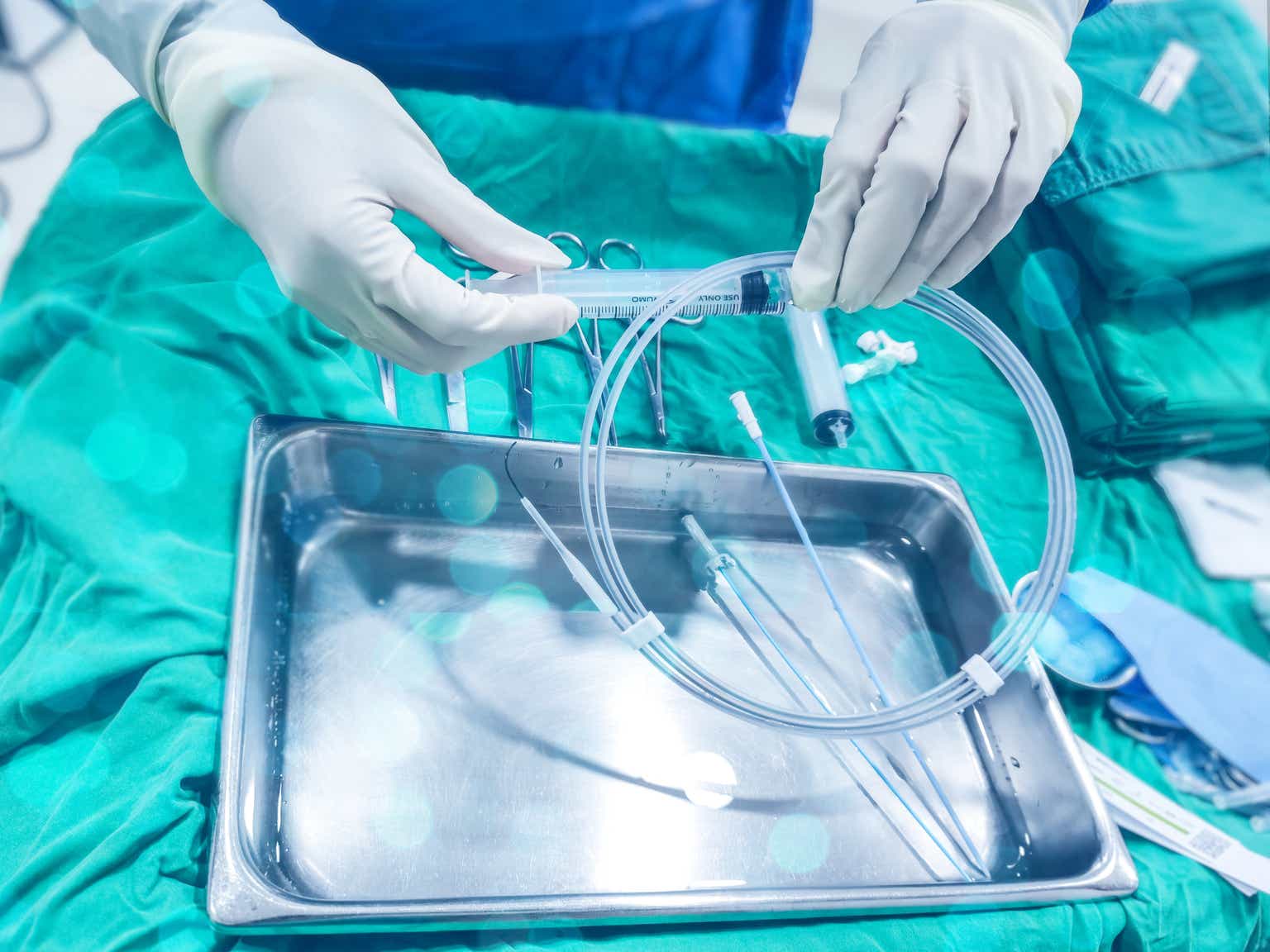This has been a challenging year for the medical device sector, In addition to ongoing worries about reimbursement and a lack of innovation, investors have also fretted about the impact of GLP-1 drugs on a host of device sub-sectors. It also hasn’t helped that the entire sector was trading at an elevated premium to the broader market going into this year. In any event, the space is down around mid-teens so far this year, with considerable weakness since the late July reporting period for Q2’23 earnings.
Haemonetics (NYSE:HAE), though, stands out as a notable exception, with the shares up around 7% since my last update, outperforming the broader market by more than 20%. Not only has the company continued to execute on growing its Hospital franchise, it has also been performing well on margins and leveraging exceptionally strong demand in plasma collection. While these plasma collection tailwinds won’t last, I do still see a path to high single-digit revenue growth with EBITDA margins in the low 30%’s, and that’s enough to support more upside for these shares.
Plasma Collections Continue To Donate Growth
I don’t think it will surprise many readers that the pandemic had a huge impact on plasma collection, as many would-be donors stayed away entirely and centers had to reconfigure their footprints to improve donor safety, reducing the number of donors and collections per day. As companies look to replenish inventories and catch up on backorders, plasma collection volumes have been running hot, driving more revenue opportunities for Haemonetics.
In the fiscal first quarter (the June calendar quarter), Haemonetics reported over 35% organic growth in the Plasma business, with 41% growth in disposables in North America. Not only are underlying collection volume trends exceptionally strong right now, the company also continues to benefit from Terumo’s (OTCPK:TRUMF) supply chain issues with its competing Rika system. Because of those issues, CSL Limited (OTCQX:CSLLY) has only managed to install Rika systems in “just over 10” of its more than 300 centers, as of CSL’s last public commentary.
I don’t expect either trend to stop right away. CSL has had to go back to Haemonetics and extend agreements to compensate for Terumo’s shortfall, and while CSL’s minimum purchases under the new agreement should total at least $100M, it looks like the potential contribution in FY’25 could still be significant as well, as Terumo is still not through their supply chain problems, let alone capable of scaling production fast enough to curtail $50M-plus of revenue opportunities for Haemonetics next year.
On the downside, this pace of plasma collection isn’t sustainable, and I do expect to see volumes tapering off later this year and into 2024. Offsetting that is the opportunity to gain share with non-CSL customers with the NexSys PCS and the Persona offering that has been shown, through clinical study, to increase donor yields by 9% to 12%.
Haemonetics Goes Back To M&A To Build The Hospital Business
While plasma collection systems (and their associated disposables and software) will be a major part of the Haemonetics business for some time to come, management has been actively reinvesting in diversifying the business – targeting its core hospital market (where it has a long history in transfusion management, cell salvage, and hemostasis products) as a platform for M&A-driven growth.
So far the company’s first major foray, the acquisition of Cardiva and its Vascade closure system, has gone rather well. Haemonetics paid $510M (including the earn-out) for this business in 2021, and as of the last quarter it is annualizing at around $150M in revenue, taking the multiple from 7.3x at the time of the deal to 3.4x in only around two years.
Better still, the company is just getting started launching this portfolio into Europe and Japan and there are still meaningful opportunities to take share from companies like Abbott (ABT) and Terumo in interventional cardiology and growth through increased procedure penetration in the large (and growing) electrophysiology market. Considering the high potential of pulsed field ablation systems from companies like Boston Scientific (BSX) for the treatment of atrial fibrillation, I expect meaningful interventional EP market growth in the coming years, creating an even larger addressable market for Haemonetics, particularly as closure devices like Vascade should be conducive to improving throughput in what is a key hospital profit center (the EP lab).
The company just recently announced another M&A transaction for the hospital business, the $253M all-cash acquisition of OpSens (OPS.:CA). This small Canadian med-tech company has two advanced guidewires approved for sale in the U.S. – the OptoWire (a guidewire that combines pressure measurement with FFR capabilities) and the SavvyWire. The latter is the more interesting product, a 3-in-1 sensor-guided guidewire for transcatheter atrial valve procedures that acts as both a pressure monitoring wire and pacing wire. The company also has a meaningful OEM business focused on fiber optic sensor technologies that serves customers in the medical and industrial sectors.
I’m somewhat cautious on the potential of the OptoWire. While management talked of a $900M addressable market growing at 8%-10%, there are competing products from Abbott, Boston Scientific, and Philips (PHG) that do the same things and those companies have considerably larger sales forces and portfolios for the interventional space. I’m more bullish on the SavvyWire, where management estimates a $200M addressable market growing double digits, as this seems like a time/hassle-saving innovation (eliminating the need for a separate pacing wire), and I’m honestly surprised Abbott or Boston Scientific don’t have one of their own.
Haemonetics paid 5.4x estimated 2023 revenue for OpSens, and at that price the company certainly needs to show that it can grow both the OptoWire and SavvyWire. The company’s existing presence in hospitals is a good start, and I like what SavvyWire offers, but I’ll need to see evidence that Haemonetics really can compete with well-established players in the cath lab and win share with OptoWire.
The Outlook
The ongoing momentum Haemonetics has in the plasma business, not to mention hemostasis and closure, should ease investor concerns about the company’s growth momentum for at least the next few quarters. Then it’s a question of how much the plasma business tapers off and whether the non-CSL business can continue to grow at an attractive double-digit rate. Beyond that, the company has to show that it can continue to take share with Vascade (particularly in new geographies at EP labs), while performance from the OpSens deal will take probably at least three years to really materialize (though there could be upside there if Haemonetics really leverages its existing salesforce and drives faster uptake/share gains).
My FY’24 revenue estimate is now about 5% higher than before, but I haven’t increased my out-year estimates as much, as I don’t think these tailwinds in plasma collection are sustainable. As I said, I could be too conservative on OpSens, but I’m looking for overall long-term revenue growth of around 8%, driven by growth in ex-CSL plasma collection, Vascade, hemostasis, and OpSens.
On the margin side, there’s still a vibrant “will they or won’t they” debate about hitting longer-term targets for high-20%’s operating margin (adjusted) and mid-to-high 30%’s EBITDA margins. I believe the company will get there, and I’m expecting high-teens free cash flow margins in around five years and 20% margins in 10 years. While the company is a little stretched on debt now, those cash flows should help pay down debt and give the company a future war chest for additional tuck-in deals to grow and diversify the Hospital business.
Between discounted cash flow and growth/margin/return-driven EV/revenue, I believe Haemonetics should trade somewhere in a range of $97 to $106 today, suggesting decent double-digit appreciation potential over the next year.
The Bottom Line
While I do have some concerns that guidance for the plasma business could soften in a few quarters, I think Haemonetics is one of the safer stories in medical devices now where revenue growth and margin leverage are concerned. I don’t that’s fully reflected in the share price, nor do I think the Street gives full credit for the longer-term potential of the plasma and hospital businesses. I think these shares are still worth owning today.
Editor’s Note: This article discusses one or more securities that do not trade on a major U.S. exchange. Please be aware of the risks associated with these stocks.
Read the full article here






